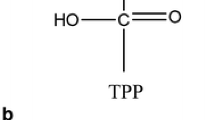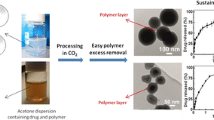Abstract
Composite silica–alginate nanoparticles were prepared via silica sol–gel technique using a water-in-oil microemulsion system. In our system, cyclohexane served as the bulk oil phase into which aqueous solutions of sodium alginate were dispersed as droplets that confined nanoparticle formation after addition of tetraethylorthosilicate (TEOS). Our studies showed that much of the particle growth is completed within the first 24 h and reaction times up to 120 h only resulted in an additional 5% increase in particle diameter. Average particle size was found to decrease with increasing water-to-surfactant molar ratio (R) and with increasing the concentration of alginate in the aqueous phase. The potential for drug loading during particle formation was demonstrated using rhodamine B as a model drug. In vitro release studies showed that particles incubated in pH 2.5 phosphate buffer released only 7% of the loaded drug in 27 days, while 42% was released in pH 7.5 phosphate buffer over the same period. Analysis of the release profile suggested that rhodamine B was homogeneously distributed throughout the particle and that the drug diffusivity was 40-fold greater in pH 7.5 buffer compared with that at pH 2.5. These results suggest that silica–alginate nanoparticles could be used as pH-responsive drug carriers for controlled drug release.

Composite nanoparticles were formed by entrapment of alginate within silica sol–gel nanoparticles. These nanoparticles showed pH-dependent in vitro release profile of rhodamine B in phosphate buffers (pH 2.5 or pH 7.5). At pH 2.5, a 7% cumulative release of rhodamine B was observed over 27 days, while 42% cumulative release was observed at pH 7.5.
Highlights
-
Composite silica-alginate nanoparticles were prepared via a silica sol-gel technique using a water-in-oil microemulsion system.
-
Average particle size was shown to be dependent on the water-to-surfactant molar ratio (R) and concentration of alginate in the aqueous phase.
-
Silica-alginate nanoparticles showed pH-dependent release of rhodamine B in phosphate buffers (pH 2.5 and pH 7.5). At pH 2.5, a 7% cumulative release of rhodamine B was observed over 27 days, while 42% cumulative release was observed at pH 7.5.
-
Analysis of the release profile suggested that rhodamine B was homogeneously distributed throughout the particle and that drug diffusivity was 40-fold greater in pH 7.5 buffer compared to that at pH 2.5.







Similar content being viewed by others
References
Ciriminna R, Sciortino M, Alonzo G, Schrijver Ad, Pagliaro M (2011) From molecules to systems: sol−gel microencapsulation in silica-based materials. Chem Rev 111(2):765–789
Shchipunov YA, Karpenko TyY (2004) Hybrid polysaccharide−silica nanocomposites prepared by the sol−gel technique. Langmuir 20(10):3882–3887
Singh V, Srivastava P, Singh A, Singh D, Malviya T (2016) Polysaccharide-silica hybrids: design and applications. Polym Rev 56(1):113–136
Coradin T, Livage J (2003) Synthesis and characterization of alginate/silica biocomposites. J Sol-Gel Sci Technol 26(1):1165–1168
Pawar SN, Edgar KJ (2012) Alginate derivatization: a review of chemistry, properties and applications. Biomaterials 33(11):3279–3305
Wylie A (1973) Alginates as food additives. Royal Society of Health Journal 93(6):309–313
Mohamad NR, Marzuki NHC, Buang NA, Huyop F, Wahab RA (2015) An overview of technologies for immobilization of enzymes and surface analysis techniques for immobilized enzymes. Biotechnol Biotechnol Equip 29(2):205–220
Boateng JS, Matthews KH, Stevens HNE, Eccleston GM (2008) Wound healing dressings and drug delivery systems: A review. J Pharm Sci 97(8):2892–2923
Lee KY, Mooney DJ (2012) Alginate: Properties and biomedical applications. Prog Polym Sci 37(1):106–126
Jain D, Bar-Shalom D (2014) Alginate drug delivery systems: application in context of pharmaceutical and biomedical research. Drug Dev Ind Pharm 40(12):1576–1584
Jaganathan H, Godin B (2012) Biocompatibility assessment of Si-based nano- and micro-particles. Adv Drug Deliv Rev 64(15):1800–1819
Vivero-Escoto JL, Huxford-Phillips RC, Lin W (2012) Silica-based nanoprobes for biomedical imaging and theranostic applications. Chem Soc Rev 41(7):2673–2685
McCarthy SA, Davies G-L, Gun’ko YK (2012) Preparation of multifunctional nanoparticles and their assemblies. Nat Protoc 7(9):1677–1693
Barbé CJ, Kong L, Finnie KS, Calleja S, Hanna JV, Drabarek E, Cassidy DT, Blackford MG (2008) Sol–gel matrices for controlled release: from macro to nano using emulsion polymerisation. J Sol-Gel Sci Technol 46(3):393–409
Heichal-Segal O, Rappoport S, Braun S (1995) Immobilization in alginate-silicate sol-gel matrix protects β-glucosidase against thermal and chemical denaturation. Biotechnology 13(8):798–800
Kawakami K, Furukawa S-Y (1997) Alcohol-oxidation activity of whole cells ofpichia postons entrapped in hybrid gels composed of Ca-alginate and organic silicate. Appl Biochem Biotechnol 67(1):23–31
Fukushima Y, Okamura K, Imai K, Motai H (1988) A new immobilization technique of whole cells and enzymes with colloidal silica and alginate. Biotechnol Bioeng 32(5):584–594
Boissière M, Allouche J, Chanéac C, Brayner R, Devoisselle J-M, Livage J, Coradin T (2007) Potentialities of silica/alginate nanoparticles as hybrid magnetic carriers. Int J Pharm 344(1–2):128–134
Boissiere M, Meadows PJ, Brayner R, Helary C, Livage J, Coradin T (2006) Turning biopolymer particles into hybrid capsules: the example of silica/alginate nanocomposites. J Mater Chem 16(12):1178–1182
Hu L, Sun C, Song A, Chang D, Zheng X, Gao Y, Jiang T, Wang S (2014) Alginate encapsulated mesoporous silica nanospheres as a sustained drug delivery system for the poorly water-soluble drug indomethacin. Asian J Pharm Sci 9(4):183–190
Feng W, Nie W, He C, Zhou X, Chen L, Qiu K, Wang W, Yin Z (2014) Effect of pH-responsive alginate/chitosan multilayers coating on delivery efficiency, cellular uptake and biodistribution of mesoporous silica nanoparticles based nanocarriers. ACS Appl Mater Interfaces 6(11):8447–8460
Wang J, Shah ZH, Zhang S, Lu R (2014) Silica-based nanocomposites via reverse microemulsions: classifications, preparations, and applications. Nanoscale 6(9):4418–4437
López-Quintela MA (2003) Synthesis of nanomaterials in microemulsions: formation mechanisms and growth control. Curr Opin Colloid Interface Sci 8(2):137–144
Wang J, Tsuzuki T, Sun L, Wang X (2010) Reverse microemulsion-mediated synthesis of SiO2-coated ZnO composite nanoparticles: multiple cores with tunable shell thickness. ACS Appl Mater Interfaces 2(4):957–960
Arriagada FJ, Osseo-Asare K (1999) Synthesis of nanosize silica in a nonionic water-in-oil microemulsion: effects of the water/surfactant molar ratio and ammonia concentration. J Colloid Interface Sci 211(2):210–220
Parveen S, Misra R, Sahoo SK (2012) Nanoparticles: a boon to drug delivery, therapeutics, diagnostics and imaging. Nanomedicine 8(2):147–166
Blanco E, Shen H, Ferrari M (2015) Principles of nanoparticle design for overcoming biological barriers to drug delivery. Nat Biotechnol 33:941–951
Chen G, Roy I, Yang C, Prasad PN (2016) Nanochemistry and nanomedicine for nanoparticle-based diagnostics and therapy. Chem Rev 116(5):2826–2885
Wilczewska AZ, Niemirowicz K, Markiewicz KH, Car H (2012) Nanoparticles as drug delivery systems. Pharmacol Rep 64(5):1020–1037
Hughes GA (2005) Nanostructure-mediated drug delivery. Nanomedicine 1(1):22–30
Kumar B, Jalodia K, Kumar P, Gautam HK (2017) Recent advances in nanoparticle-mediated drug delivery. J Drug Deliv Sci Technol 41:260–268
Chia‐Lu C, Scott FH (1996) Kinetics of silica particle formation in nonionic W/O microemulsions from TEOS. AICHE J 42(11):3153–3163
Jaramillo N, Paucar C, García C (2014) Influence of the reaction time and the Triton x-100/Cyclohexane/Methanol/H2O ratio on the morphology and size of silica nanoparticles synthesized via sol–gel assisted by reverse micelle microemulsion. J Mater Sci 49(9):3400–3406
Soares JP, Santos JE, Chierice GO, Cavalheiro ETG (2004) Thermal behavior of alginic acid and its sodium salt. Eclet Quím 29:57–64
Zhuravlev LT (2000) The surface chemistry of amorphous silica. Zhuravlev model. Colloids Surf A 173(1–3):1–38
Donnan FG, Rose RC (1950) Osmotic pressure, molecular weight, and viscosity of sodium alginate. Can J Res 28b(3):105–113
Osseo-Asare K, Arriagada FJ (1990) Preparation of SiO2 nanoparticles in a non-ionic reverse micellar system. J Colloids Surf 50:321–339
Bagwe RP, Yang C, Hilliard LR, Tan W (2004) Optimization of dye-doped silica nanoparticles prepared using a reverse microemulsion method. Langmuir 20(19):8336–8342
Ab Rahman I, Padavettan V (2012) Synthesis of silica nanoparticles by sol-gel: size-dependent properties, surface modification, and applications in silica-polymer nanocomposites-a review. J Nanomat. https://doi.org/10.1155/2012/132424
Arriagada FJ, Osseo-Asare K (1994) Synthesis of nanometer-sized silica by controlled hydrolysis in reverse micellar systems. In: Horacio EB (ed). The Colloid Chemistry of Silica. American Chemical Society, Washington, DC
Finnie KS, Bartlett JR, Barbé CJA, Kong L (2007) Formation of silica nanoparticles in microemulsions. Langmuir 23(6):3017–3024
Lal J, Auvray L (1994) Perturbations of microemulsion droplets by confinement and adsorption of polymer. Journal de Physique II 4(12):2119–2125
Stubenrauch C (2008) Microemulsions: background, new concepts, applications, perspectives. 1st edn. Wiley-Blackwell, Hoboken, NJ
Siepmann J, Siepmann F (2008) Mathematical modeling of drug delivery. Int J Pharm 364(2):328–343
Ritger PL, Peppas NA (1987) A simple equation for description of solute release I. Fickian and non-fickian release from non-swellable devices in the form of slabs, spheres, cylinders or discs. J Control Release 5(1):23–36
Dash S, Murthy PN, Nath L, Chowdhury P (2010) Kinetic modeling on drug release from controlled drug delivery systems. Acta Pol Pharm 67(3):217–223
Li L, Li J, Si S, Wang L, Shi C, Sun Y, Liang Z, Mao S (2015) Effect of formulation variables on in vitro release of a water-soluble drug from chitosan–sodium alginate matrix tablets. Asian J Pharm Sci 10(4):314–321
Chen J, Huang G-D, Tan S-R, Guo J, Su Z-Q (2013) The preparation of capsaicin-chitosan microspheres (CCMS) enteric coated tablets. Int J Mol Sci 14(12):24305–24319
Cuomo F, Ceglie A, Piludu M, Miguel MG, Lindman B, Lopez F (2014) Loading and protection of hydrophilic molecules into liposome-templated polyelectrolyte nanocapsules. Langmuir 30(27):7993–7999
Siepmann J, Siepmann F (2012) Modeling of diffusion controlled drug delivery. J Control Release 161(2):351–362
Author information
Authors and Affiliations
Corresponding author
Ethics declarations
Conflict of interests
The authors declare that they have no conflict of interest.
Financial & disclosure
This material was partially supported by National Science Foundation Award #1622068.
Additional information
Publisher’s note: Springer Nature remains neutral with regard to jurisdictional claims in published maps and institutional affiliations.
Rights and permissions
About this article
Cite this article
Fan, X., Domszy, R.C., Hu, N. et al. Synthesis of silica–alginate nanoparticles and their potential application as pH-responsive drug carriers. J Sol-Gel Sci Technol 91, 11–20 (2019). https://doi.org/10.1007/s10971-019-04995-4
Received:
Accepted:
Published:
Issue Date:
DOI: https://doi.org/10.1007/s10971-019-04995-4




